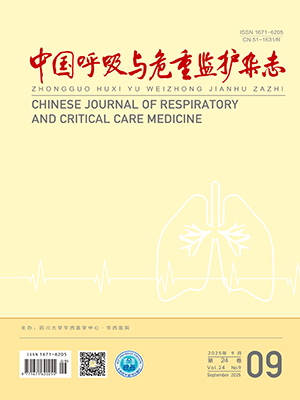Objective To investigate the effects of positive end-expiratory pressure (PEEP) level on end-expiratory lung volume (EELV) during assisted ventilation in chronic obstructive pulmonary disease (COPD) patients,to provide physiological evidence to guide optimal setting of PEEP level in clinical practice.Methods Eight intubated patients with acute exacerbation of COPD were recruited for the study when the patients were in relatively stable condition after treatment.The static intrinsic PEEP (PEEPistat) and dynamic intrinsic PEEP (PEEPidyn) were measured by using airway occlusion method and esophageal balloon-tipped catheter technique,respectively.Changes in EELV (ΔEELV) were measured with inspiratory capacity (IC) method.Relations between PEEP level and ΔEELV were analyzed by curve estimation method.Results ΔEELV as a function of level of PEEP was shown as a sigmoid model.The low inflection points of the curves when PEEP levels were expressed as PEEP/PEEPistat ratio,PEEP/PEEPidyn ratio or actual PEEP setting (PEEP-a) were 0.74,0.76 or 3.6 cm H2O,respectively.The corresponding ΔEELV expressed as ΔEELV/IC(%) were 9.6%,9.1% and 7.4%,respectively.Conclusions In AECOPD patients demanding mechanical ventilation,the changes of lung volume (ΔEELV) in response to progressive increase of PEEP level were shown to be a sigmoid model.Setting PEEP level at 0.74 of PEEPistat,or 0.76 of PEEPidyn can avoid the steep increase of lung volume.
Citation: QIN Zhaohui,CHEN Rongchang,ZHONG Nanshan. Effects of positive end expiratory pressure level on end-expiratory lung volume during assisted ventilation in chronic obstructive pulmonary disease. Chinese Journal of Respiratory and Critical Care Medicine, 2007, 6(1): 23-26. doi: Copy
Copyright © the editorial department of Chinese Journal of Respiratory and Critical Care Medicine of West China Medical Publisher. All rights reserved




